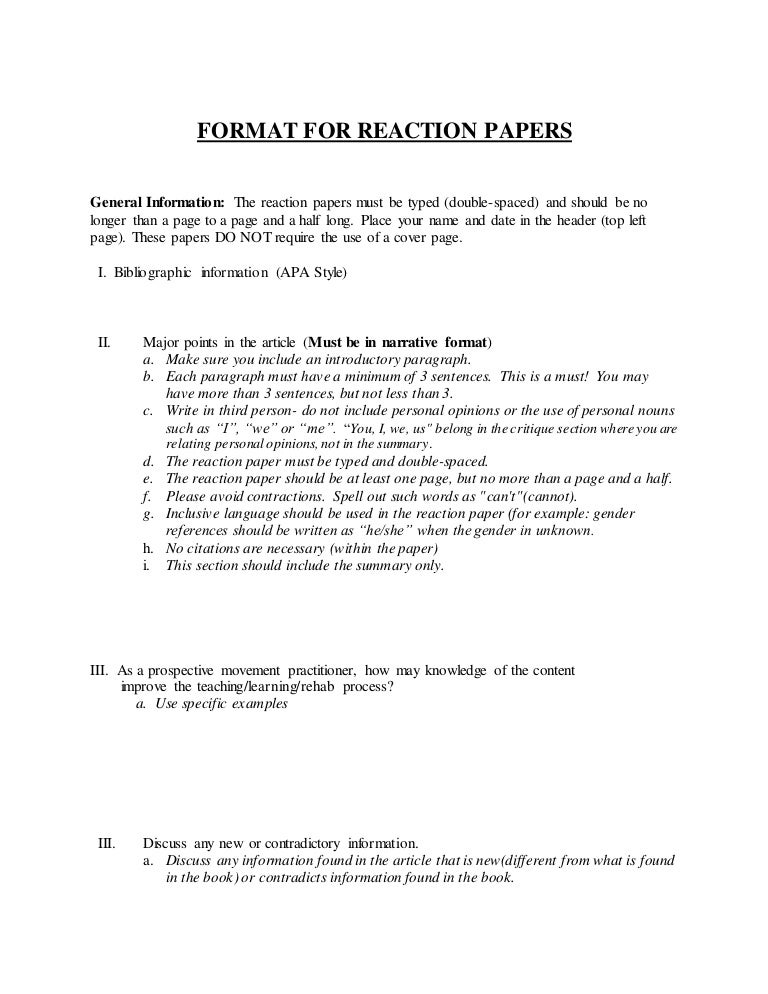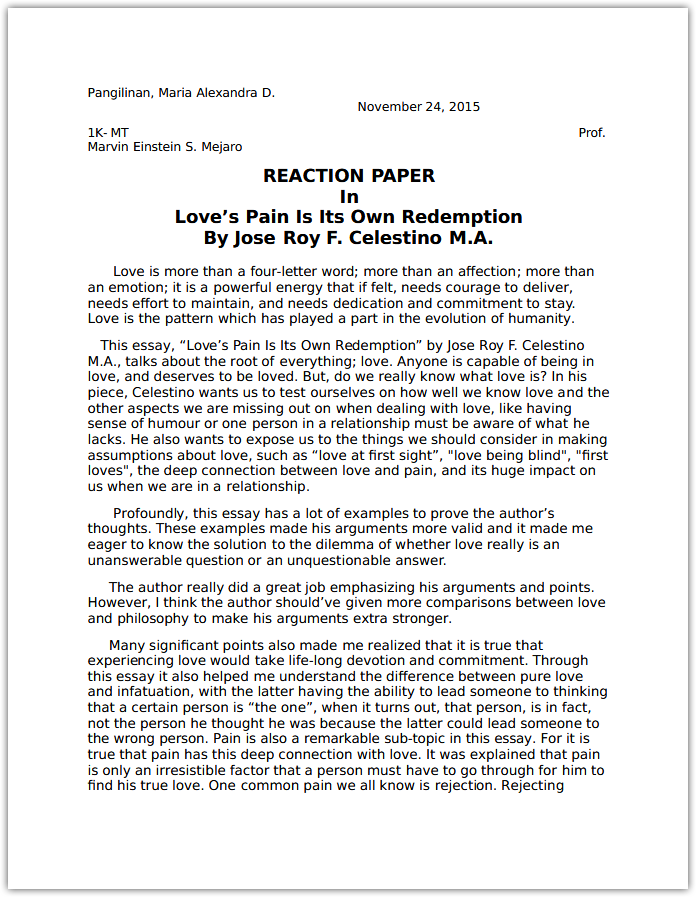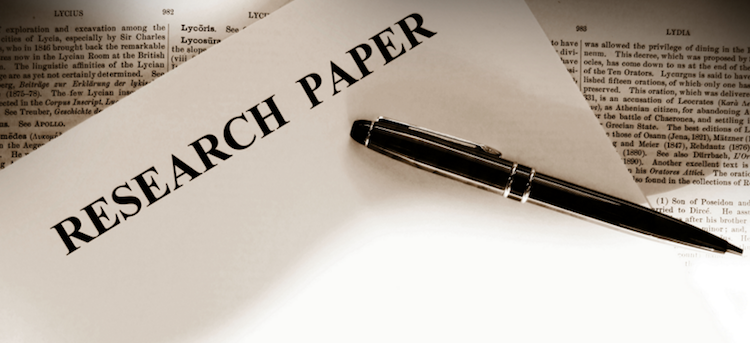
· A reaction paper is the right assignment to show your attainments of analysis and critical thinking. The reaction paper concept is reminiscent of a mixture of a research paper and an expository essay. You must provide basic information about the text that you will analyze. This includes the author, publication date, and idea of the article · A reaction paper is a form of essay in which you reveal your thoughts about a play, book, article, or any other literary work. This kind of academic writing has many parallels with a reaction paper because it contains your reaction to the reviewed work That is why if you want to know how to write a reaction paper, you should first remember that it is a task, where you need to summarize obtained information and write down your reaction. Here are the main things you need to consider, when working on your reaction paper
Writing a Response or Reaction Paper — Hunter College
A reaction paper is a great way to explore your thoughts and opinions in response to a piece of work you've read, heard or seen. In this article, reaction paper discuss what a reaction is, its importance and how to write one. Related: 5 Steps for Great Business Writing With Tips. A reaction reaction paper is a written assignment that provides a personal opinion regarding a given piece of work.
The paper should include a short summary of the work, reaction paper, but the main focus is your thoughts, feelings and rationalizations about what's discussed in the original text. This requires analysis of the given work reaction paper your part, followed by a focused, well-thought-out reaction backed by outside sources, where applicable. Your reaction paper should consist of four main parts: 1. Introduction 2. Reaction paper 3. Conclusions 4. List of citations and sources.
Related: Guide to Submitting a Writing Sample. The introduction of your paper serves to lay out your ideas and to pique the interest of your readers. A great place to start reaction paper to name the author and the work that you are reacting to, reaction paper, elucidating the main focus of reaction paper you are going to discuss. This part should be about three or four sentences, closing with your thesis statement. Keep your thesis statement concise, because you'll reference it several times throughout your paper.
Here are the suggested steps for structuring and writing this paper:. It's crucial that you fully understand why you're writing and what you're reacting to.
You may find yourself going back to reread or rewatch, depending on the medium, to make sure you understand completely what is being presented to you. As you do so, take notes on parts that you find important so you can easily refer back to them later. Go back through your notes to get an idea of your overarching angle. This will help you form the main idea you will fully develop in your reaction.
Craft a clear, concise statement as your thesis, ideally in a single sentence. Again using your notes, start building the framework for your arguments. Fleshing out these ideas while writing your reaction will be much easier and more organized when you're following an outline. Use your outline to form the first reaction paper of your work.
This will be rough but should give you a clear idea of what the finished product is going to look like. Tip: write your introduction last. It's very frustrating to write your whole paper only to realize that you deviated from your thesis pages ago. Circling back to it after writing the rest allows you to tweak the way you stated your thesis, if necessary. There's a possibility that you'll be producing two, three or even four drafts before the final polished piece is ready to go.
For each pass through the paper during editing, focus on one main thing that you're editing for. For example, the first pass might be focused on spelling, grammar and punctuation. The next pass could be looking at the organization of ideas, and so on. You'll make as many passes as you need to to create exactly what you want to present. The first part of your paper will include a quick, objective summary of the work you're reaction paper to.
It should include the author's name and the title of the piece as well as the publication date. The summarization itself should be a highlight reel of the main reaction paper and a condensed explanation of the key supporting elements. You should feel free to use direct quotes for ideas that you deem are especially important to your reaction.
At this point, it's unnecessary to go into detail on any one point or introduce any subjective opinions. That will come later.
The second part of the paper is where you express your opinions on the key points of the work, supported by reliable sources. For each point in your reaction, circle back to reference the corresponding part in the original piece.
This is your analysis, the most important section of this paper, reaction paper. Your evaluation should discuss the accuracy, organization, importance and completeness of the work.
This is where you'll take a stance on whether you recommend this work to others and the reasons for your answer. Your conclusions should be presented concisely and reiterate your thesis and the main points that took shape as you wrote.
Finally, your cited sources should be reaction paper according to the writing style you're using MLA, APA. Related: How to Write a Summary of Qualifications, reaction paper. Here are some tips to consider as you move through the writing process:.
Skip to main content Indeed Home. Find jobs Company reviews Find salaries. Upload your resume. Sign in. Find jobs, reaction paper. Company reviews. Find salaries. Create your resume. Change country ���� United States. Help Center. Career Development. What is a reaction paper? How to write a reaction paper. Read and analyze the work thoroughly. Craft your thesis statement. Create the paper's outline, reaction paper.
Compose a first draft. Polish and repeat. Writing your paper. Part 1: The introduction and summary. Part 2: Your thoughts, feelings and reaction paper. Follow the basic template for writing a paper, with each major paragraph addressing one main idea. For example, your first paragraph introduces and summarizes the work, followed by three or four paragraphs that state and support separate reactions to the work.
The final paragraph should be a short conclusion. Reaction paper paragraph should transition smoothly into the next. Be sure to support your points and opinions with specific examples. Proofread again. Have others proofread for you. Proofread one last time. It's fine to use quotations from the original work to support your points, reaction paper, but don't be overly reliant on them. Express your opinions clearly, reaction paper. The point of a reaction paper reaction paper to react with your own thoughts and feelings, reaction paper.
Feel free to express yourself in a thoughtful, well-constructed manner. Remember that your critiques must be backed with evidence and examples to hold the attention of your readers. Make sure you're applying the basic standards of effective writing unity, coherence, supporting facts and clear, concise sentences when writing and editing.
Related View More arrow right. How To Complete Audience Segmentation in 4 Steps Learn about what audience segmentation is, why audience segmentation matters, ways to segment your audience and how to complete audience segmentation.
How to Do a Reaction Paper of a Documentary Movie : English \u0026 Writing Lessons
, time: 1:52How to write a reaction paper. Examples & Samples at KingEssays©

A reaction paper adopts different formats depending on the instructions given. A reaction paper is divided into several parts. To organize your work, you have to understand every part of the essay and what it entails. In a reaction paper, just like in any other essay format, there is the introduction, the body, and the conclusion A reaction paper is a type of written assignment, which requires personal opinion and conclusions on a given article or abstract. Unlike a summary, a reaction paper should contain your own thoughts on the problem, discussed in the original text A reaction paper is a written assignment that provides a personal opinion regarding a given piece of work. The paper should include a short summary of the work, but the main focus is your thoughts, feelings and rationalizations about what's discussed in the original text

No comments:
Post a Comment